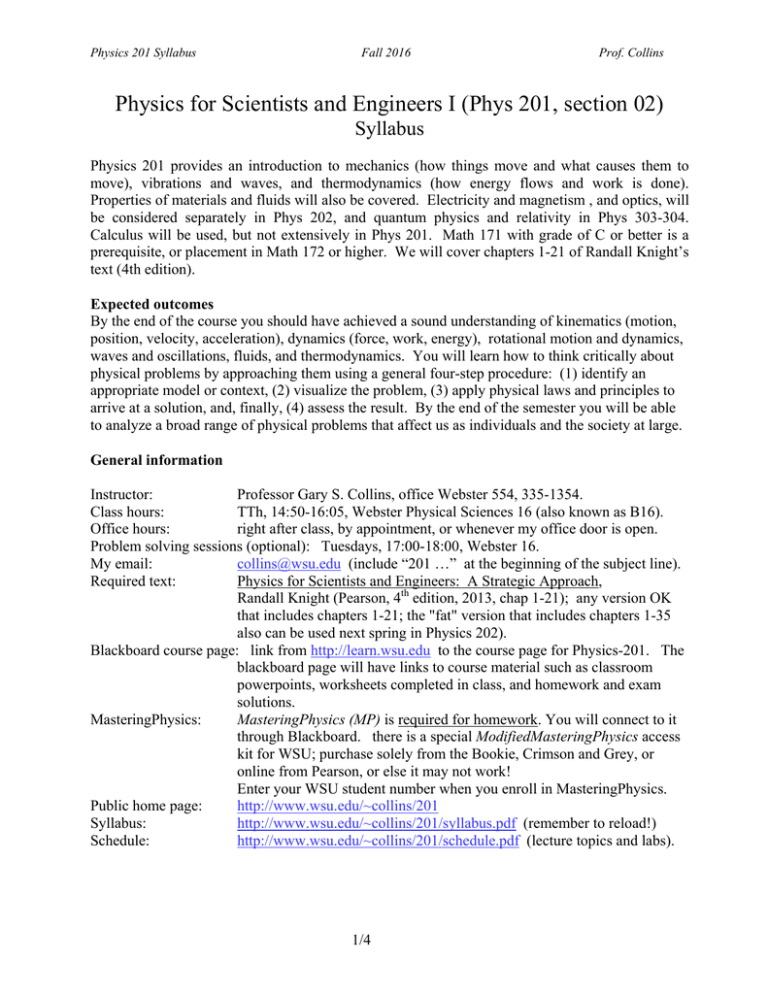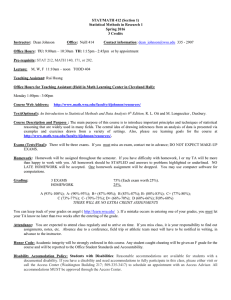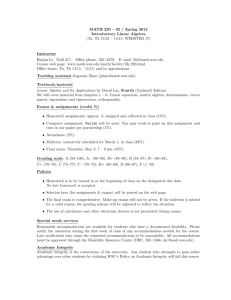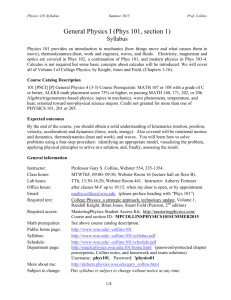Physics 201 - Washington State University
advertisement

Physics 201 Syllabus Fall 2016 Prof. Collins Physics for Scientists and Engineers I (Phys 201, section 02) Syllabus Physics 201 provides an introduction to mechanics (how things move and what causes them to move), vibrations and waves, and thermodynamics (how energy flows and work is done). Properties of materials and fluids will also be covered. Electricity and magnetism , and optics, will be considered separately in Phys 202, and quantum physics and relativity in Phys 303-304. Calculus will be used, but not extensively in Phys 201. Math 171 with grade of C or better is a prerequisite, or placement in Math 172 or higher. We will cover chapters 1-21 of Randall Knight’s text (4th edition). Expected outcomes By the end of the course you should have achieved a sound understanding of kinematics (motion, position, velocity, acceleration), dynamics (force, work, energy), rotational motion and dynamics, waves and oscillations, fluids, and thermodynamics. You will learn how to think critically about physical problems by approaching them using a general four-step procedure: (1) identify an appropriate model or context, (2) visualize the problem, (3) apply physical laws and principles to arrive at a solution, and, finally, (4) assess the result. By the end of the semester you will be able to analyze a broad range of physical problems that affect us as individuals and the society at large. General information Instructor: Professor Gary S. Collins, office Webster 554, 335-1354. Class hours: TTh, 14:50-16:05, Webster Physical Sciences 16 (also known as B16). Office hours: right after class, by appointment, or whenever my office door is open. Problem solving sessions (optional): Tuesdays, 17:00-18:00, Webster 16. My email: collins@wsu.edu (include “201 …” at the beginning of the subject line). Required text: Physics for Scientists and Engineers: A Strategic Approach, Randall Knight (Pearson, 4th edition, 2013, chap 1-21); any version OK that includes chapters 1-21; the "fat" version that includes chapters 1-35 also can be used next spring in Physics 202). Blackboard course page: link from http://learn.wsu.edu to the course page for Physics-201. The blackboard page will have links to course material such as classroom powerpoints, worksheets completed in class, and homework and exam solutions. MasteringPhysics: MasteringPhysics (MP) is required for homework. You will connect to it through Blackboard. there is a special ModifiedMasteringPhysics access kit for WSU; purchase solely from the Bookie, Crimson and Grey, or online from Pearson, or else it may not work! Enter your WSU student number when you enroll in MasteringPhysics. Public home page: http://www.wsu.edu/~collins/201 Syllabus: http://www.wsu.edu/~collins/201/syllabus.pdf (remember to reload!) Schedule: http://www.wsu.edu/~collins/201/schedule.pdf (lecture topics and labs). 1/4 Physics 201 Syllabus Fall 2016 Prof. Collins Course format and grading Grading The course grade will be based on homework and three hour exams, the laboratory, and a final exam. See the absolute grading scale below. Exams will be closed-book; however, I will provide an equation sheet ahead of each exam that will also appear on the exam to help you prepare for the exam. (The equation sheet is a guide, it will not include every equation you might need to use.) Contributions to your final grade Homework + Hour Exams 45% Laboratory 25% Final exam 30% Grading scale (with pluses and minuses) A 85-100 % B 70-85 % C 55-70 % D 45-55 % Class format In class you will be introduced to new topics, shown physics demonstrations, shown the kinds of problems that one can solve and how to approach them, see problems from a workbook worked through, and practice solving other problems in small groups. Generally, problems will be more qualitative in class and more quantitative in the homework. Homework Homework will be assigned for each chapter and graded online. Due dates will be given on the MP Course Schedule and will normally be one week following presentation of new material in class. Assignments should be completed by the start of class time Attend to homework deadlines! Late homework gets no credit! Homework is scored uniformly at 1 point per problem. Exams Exam problems will generally be similar to homework problems, sample problems in the text, and workbook exercises. Three hour exams are scheduled. NO make-up exams will be given. A missed exam counts as a 0 grade (zero). However, your lowest hour exam grade will be replaced by a greater cumulative homework score at the end of the semester. Thus, in addition to testing your understanding of the subject and helping you to prepare for exams, a good homework grade provides "insurance" against a low exam grade. The final exam will be Thursday, December 15, 10:10-13:00, in the usual classroom, Webster 16. You should bring a scientific calculator and writing implements to each exam. With my prior approval, non-native English-speaking students may also bring an electronic dictionary to exams. Laboratory Attendance in the laboratory is mandatory. Deficient performance (defined as less than 50%) in the laboratory will result in a failing grade for the entire course. The lab manual and lots of useful information can be accessed from the web site for Physics-201 labs at http://hub.wsu.edu/physlabs/physics-201/. For details on laboratory grading refer to the Physics Lab Syllabus in the lab manual. Paper copies of the lab manual will be distributed to students during the first lab session, but you will need to bring your own lab notebook with carbonless copies. They may be purchased at the Bookie or online. Physics 201 laboratories will begin meeting the first week of classes, beginning August 23. The last regular laboratory exercises will be during the week of November 28, the week before Closed Week. All laboratory work must be completed and submitted before 5 PM the Monday of Closed Week, December 5. 2/4 Physics 201 Syllabus Fall 2016 Prof. Collins The lab exam will be administered during Closed Week, during your regular lab session. I will orient you to upcoming laboratories each week, but grading of labs is completely independent of the lecture component of the course! Questions about lab procedures and grading should be directed to your laboratory teaching assistant or to Dr. Stephen Langford, Director of Laboratories, Webster 328, 335-3398. A different grading scale is used in the labs (e.g., 80-90= "B"), so that your final lab grade will be converted to the scale used for the lecture part of the course before computing your final grade. Tips for doing well Read “Preface to the Student” in the textbook. Attend classes and ask questions. Follow workbook solutions in class and review them (solutions will be posted). Read ahead each day. Frame questions from your readings. Do the homework. Get smart! Students who try to get by without doing homework are very likely to fail the course. Keeping up with homework helps you practice what you are learning. It is also "insurance" against a low exam grade. Expect to devote 2-4 hours of effort to complete homework for each chapter. Study with fellow students. It is great to discuss approaches to solving homework problems with your peers. However, submitted homework and exam solutions must be entirely your own. Any kind of cheating will have serious consequences. Attend optional problem solving sessions on Tuesdays at 17:00. Meet with me. Don’t hesitate to contact me with questions or to seek help. To get the most effective help, make a list ahead of time of items you don’t understand. It`s my job to help you! Free tutoring is expected to be available starting in a week or two. Private tutoring can also be arranged by contacting the Physics Department office in Web room 1243. Other resources. Check out the great tutorial videos at Khan’s Academy: https://www.khanacademy.org/science/physics. Two notes about learning physics (1) Before they study physics, many students have incorrect ideas about how the world works. In the course of your study, you may need to “unlearn” incorrect thinking as much as you learn to apply the laws of physics correctly. For example, a common misconception is that if no force is acting on a moving object, it will slow down and stop. A more correct understanding will come through proper application of Newton’s three laws of mechanics. I will help you address such misconceptions. 3/4 Physics 201 Syllabus Fall 2016 Prof. Collins (2) Several centuries ago, physics was called "natural philosophy". That is because one applies scientific principles or laws in a logical way to understand and explain natural phenomena. More than in most disciplines, physics builds on a foundation of basic principles. It is important to understand and know how to interpret the basic principles. Students who do not achieve a good understanding of the basics very often get quickly lost and overwhelmed as the course progresses. Keep up! Important fine print to read Academic Integrity: Academic dishonesty, including all forms of cheating, plagiarism, and fabrication, is prohibited. Violations of the academic standards for the lecture or lab, or the Washington Administrative Code on academic integrity (apps.leg.wa.gov/WAC/default.aspx?cite=504-26), may result in a failing grade for the course. Incidents of academic dishonesty will be referred to the Office of Student Conduct. A faculty member’s decision relating to academic integrity may be appealed by completing the form at conduct.wsu.edu. Disability Accommodations: Reasonable accommodations are available for students with documented disabilities. If you have a disability and need accommodation to fully participate in the lecture or lab, contact the Access Center (Phone: 335-3417, E-mail: access.center@wsu.edu, URL: accesscenter.wsu.edu) to schedule an appointment with an Access Advisor. All accommodations must be approved through the Access Center. Both your lecture instructor and the lab director must be notified of approved accommodations during the first week of lecture. Accommodations might not be available if requested later. Campus Safety: Students and staff are expected to be familiar with emergency procedures. General information on campus safety is posted at safetyplan.wsu.edu. Information on how to prepare for specific emergencies can be found at oem.wsu.edu. Weather warnings and safety alerts are posted promptly at alert.wsu.edu. Urgent warnings that apply to the entire University community will also be broadcast using the Campus Outdoor Warning System (speakers mounted on Holland Library and other buildings) and the Crisis Communication System (e-mail, phone, cell phone). It is important to keep your emergency contact information up to date in MyWSU. To enter or update this information, click on the “Update Now!” link in the “Pullman Emergency Information” box on your MyWSU home page, at my.wsu.edu. An Emergency Guide is posted near each exit of each lecture room. If faced with an emergency, follow the “Alert, Assess, Act,” protocol: Remain ALERT (through direct observation or emergency notification), ASSESS your specific situation, and ACT to ensure your own safety and the safety of those around you. In case of fire, leave the building, using the stairs if necessary; do not use the elevators. If the emergency involves an active shooter, your options are to RUN, HIDE, or FIGHT (oem.wsu.edu/emergency-procedures/active-shooter). Each door in the lecture and lab rooms can be locked from the inside in case of a lock down. Syllabus subject to change. Gary S. Collins, August 21, 2016 4/4


